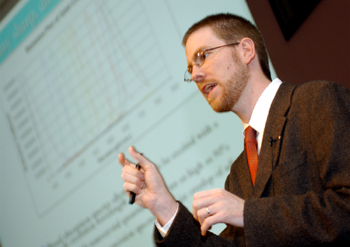
Marcel Bruchez, Ph.D., a principal scientist at Quantum Dot Corporation, was one of the speakers at this year's Joel G. Hardman Pharmacology Forum. (photo by Dana Johnson)
Forum encourages ‘small thinking’ through nanotechnology research
“Think small” could have been the mantra of last week’s Joel G. Hardman Student-Invited Pharmacology Forum. Speakers at the afternoon symposium described advances in nanotechnology, an area of science and technology focused on atomic and molecular scale structures.
A nanometer is one billionth of a meter, which “means nothing,” according to James K. Gimzewski, Ph.D., professor of Chemistry at the University of California Los Angeles and one of the featured speakers. “Once something gets this small, it just disappears,” he said.
Gimzewski is renowned in the field of nanotechnology for his pioneering work with scanning tunneling microscopy (STM). STM employs a very sharp tip as a probe to “push” atoms around. Using STM, Gimzewski was the first to observe the action of a heat-driven molecular “wheel,” a molecule turning around a central axis. He is also listed in the “Guinness Book of World Records” for building the world’s smallest calculator — an abacus using nanometer-sized “bucky balls.”
Gimzewski described his group’s recent efforts using STM to turn a chemical bond “by hand” and to detect the surface motion of cells.
Naomi Halas, Ph.D., Stanley C. Moore Professor of Chemistry at Rice University, discussed plasmonic nanostructures and their potential biological applications. Plasmonics, she said, relates to the optical properties of metals. It has long been recognized, for example, that small gold particles in a mixture appear red. This is the secret of “ruby glass,” a deep red glass used for stained glass art.
Halas and colleagues developed a method for coating a gold shell onto another material. These gold “nanoshells” are biocompatible and small enough to pass through the circulatory system. They absorb light and could be used for deep tissue imaging, she said. Other potential applications include blood testing, optically triggered drug delivery, and targeted cancer cell death. With modifications, nanoshells might seek out tumors, which could then be imaged, biopsied, and targeted with light to provoke cell death, she said.
“This work is really baby steps,” Halas said, echoing a sentiment expressed by all three speakers that nanotechnology is still in its infancy.
Marcel Bruchez, Ph.D., principal staff scientist at Quantum Dot Corporation, shared his company’s efforts to develop “quantum dots” —nanocrystals of cadmium selenide that, depending on their size, absorb and emit different colors of light. These nanocrystals are finding applications in biological imaging of cells and tissues.
Quantum dots offer improvements over traditional dyes used for fluorescence microscopy because they are extremely bright, have stable signals that do not fade over time, and offer opportunities for simultaneous imaging of multiple colors.
Vanderbilt investigators Sandra J. Rosenthal, Ph.D., assistant professor of Chemistry and Physics, and Randy D. Blakely, Ph.D., Allan D. Bass Professor of Pharmacology, have used quantum dot nanocrystals to image the dopamine transporter in living cells. The work is one example of research being conducted under the auspices of the Vanderbilt Institute for Nanoscale Science & Engineering (http://vinse.vanderbilt.edu/).
The annual student-organized pharmacology forum, now in its 12th year, honors Joel G. Hardman, Ph.D., professor of Pharmacology Emeritus. Hardman was chair of the department of Pharmacology from 1975 to 1990, and he served as associate vice chancellor for Health Affairs until his retirement in 1997.
The students named the forum in honor of Hardman to recognize his commitment to graduate student education, said Joey V. Barnett, Ph.D., associate professor of Pharmacology, Medicine and Microbiology and Immunology and director of Graduate Studies in Pharmacology.
“Joel encouraged students to think outside the box,” said Barnett, who was a graduate student in the department during Hardman’s tenure as chair. “He always worked hard to get the personal best out of each student.”
Prior to the symposium presentations, Dr. Ronald B. Emeson, Joel G. Hardman Professor of Pharmacology, received the 2003 Teaching Award in Pharmacology.
“It’s particularly nice to be recognized by the students in Pharmacology, because our department places emphasis on graduate training,” said Emeson, who also won the award in 1995.
The student organizers of this year’s forum were Aaron Hata, Xinran Hu, Andrew Lundquist, and Michelle Mazei.













